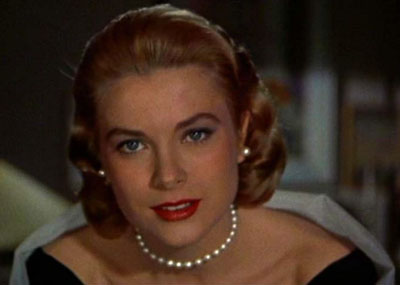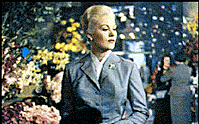


First published in Screen 16:3 (1974): 6-18.
“The meaning of woman is sexual difference.” (Laura Mulvey)
“For him she is sex—absolute sex, no less. She is defined and differentiated
with reference to man and not he with reference to her; she is the incidental,
the inessential as opposed to the essential. He is the Subject, he is the
Absolute—she is the Other.”
(Simone de Beauvoir, The Second Sex, 14).



"One might simplify this by saying: men act and
women appear. Men look at women. Women watch themselves being looked at.
This determines not only most relations between men and women but also the
relation of women to themselves. The surveyor of woman in herself is male: the
surveyed female. Thus she turns herself into an object--and most particularly an
object of vision: a sight."
(John Berger, Ways of Seeing, 47)
"But the essential way of seeing women, the essential use
to which their images are put, has not changed. Women are depicted in quite a
different way from men--not because the feminine is different from the
masculine--but because the 'ideal' spectator is always assumed to be male and
the image of the woman is designed to flatter him."
(John Berger, Ways of Seeing, 64)
John Berger's concepts quoted above derive from and coincide with Laura Mulvey's generative article, "Visual Pleasure and Narrative Cinema." Published in 1974, Mulvey's article is one of the most widely cited and anthologized (though certainly not one of the most accessible) articles in the whole of contemporary film theory, and it dominated feminist film theory during the 1980s and after.
Laura Mulvey did not undertake empirical studies of actual filmgoers, but declared her intention to make ‘political use’ of Freudian psychoanalytic theory (in a version influenced by the later theorist Jacques Lacan) in a study of cinematic spectatorship. Such psychoanalytically-inspired studies of spectatorship do not investigate the viewing practices of individuals in specific social contexts; instead, they focus on how ideological 'subject positions' are constructed by media texts.
Mulvey particularly investigates Freud's discussion of (infantile) scopophilia - the pleasure involved in looking at other people’s bodies as objects--particularly as erotic objects. In the darkness of the cinema auditorium, one may look without being seen either by those on screen by other members of the audience. Mulvey argues that such features of cinema viewing conditions facilitate for the viewer both the voyeuristic process of objectification of female characters and also the narcissistic process of identification with an ideal version of the self (the ego-ideal) seen on the screen.
She declares that in patriarchal society ‘pleasure in looking has been split between active/male and passive/female.’ This is reflected in the dominant forms of cinema. Conventional narrative films in the ‘classical’ Hollywood tradition not only typically focus on a male protagonist in the narrative but also assume a male spectator. ‘As the spectator identifies with the main male protagonist, he projects his look onto that of his like, his screen surrogate, so that the power of the male protagonist as he controls events coincides with the active power of the erotic look, both giving a satisfying sense of omnipotence.’ Traditional films present men as active, controlling subjects and treat women as passive objects of desire for men in both the story and in the audience, and do not allow women to be desiring sexual subjects in their own right. Such films objectify women in relation to ‘the controlling male gaze’, presenting ‘woman as image’ (or ‘spectacle’) and man as ‘bearer of the look’. (It was Mulvey who coined the frequently used term 'the male gaze'.) Men do the looking; women are there 'to be looked at'. The cinematic codes of popular films ‘are obsessively subordinated to the neurotic needs of the male ego’.
[Compare these ideas with John Berger's assessment and analysis of gender roles in advertising in chapters 2-3 of Ways of Seeing.]
Mulvey distinguishes between two modes of looking for the film spectator: voyeuristic and fetishistic, which she presents in Freudian terms as responses to male ‘castration anxiety’. Voyeuristic looking involves a controlling gaze and Mulvey argues that this has associations with sadism (punishment and/or demystification): ‘pleasure lies in ascertaining guilt - asserting control and subjecting the guilty person through punishment or forgiveness’. Fetishistic looking, in contrast, involves ‘the substitution of a fetish object or turning the represented figure itself into a fetish so that it becomes reassuring rather than dangerous. This builds up the physical beauty of the object, transforming it into something satisfying in itself. The erotic instinct is focused on the look alone’. Fetishistic looking, she suggests, leads to overvaluation of the female image and to the cult of the female movie star. Mulvey argues that the film spectator oscillates between these two forms of looking: sadistic voyeurism and fetishistic scopophilia (see also Neale 1992, 283ff; Ellis 1982, 45ff; Macdonald 1995, 26ff; Lapsley & Westlake 1988, 77-9).
[The above passage is adapted from Daniel Chandler's "Notes on 'The Gaze'"]
| Male | Female |
| Active | Passive |
| The one who looks (the male character who is "the bearer of the look") | Erotic object for the characters within the screen story (connotes "to-be-looked-at-ness") |
| Advances the narrative (the hero who makes things happen | Freezes the narrative (stalls the flow of action with moments of performance, seduction, eroticism) |
| Controls the film fantasy (“projects fantasy onto female figure, which is styled accordingly”) | Figures as spectacle within this fantasy |
| Bearer of the look of the spectator | Erotic object for the spectator within the auditorium |
Phallocentrism—advancement of the masculine as the source of power and meaning through cultural, ideological, and social systems (Routledge Dictionary of Feminism and Postfeminism)
Scopophilia—pleasure in looking
Narcissism—self-love, or an extreme focus on the self and one’s own desires
Castration anxiety—the presence of the female figure frightens the male, since he realizes that he, too, could be without a penis
Fetish—an object (i.e. high-heels, a feather boa, costume, prop, etc.) that distracts the male’s attention from the castration anxiety represented by woman and therefore allows him to look at the woman pleasurably without fear.
Copyright 2007: Virginia Bonner